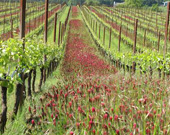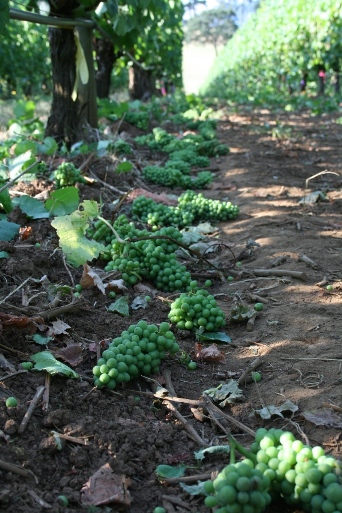 Crop thinning, or the removal of flower and grape clusters, is used to achieve yield and quality goals.
Crop thinning, or the removal of flower and grape clusters, is used to achieve yield and quality goals.Overview Timing Amount More information
Patty Skinkis, Oregon State University
Crop thinning is used to achieve yield and quality goals. Crop thinning is the term used for removal of flower and/or grape clusters on the grapevine. It allows the grower to modify vine balance (fruit to vegetative growth). In cool climate winegrowing regions, crop restriction is sometimes required on certain cultivars to ripen fruit adequately, due to a limited season and heat units. The intensity of crop thinning is highly dependent on the cultivar, vine health, and climate. Some cultivars may require annual crop thinning to maintain adequate vine strength. When thinning clusters, one must consider when and how much to thin the crop.
Timing
Many crop level studies have been conducted over the years to determine appropriate thinning practices for various cultivars in different regions. Timing is based on the berry development stage and the desired outcome. Thinning inflorescences (flower clusters) prior to bloom is one option; however, it is not often used by growers. The potential benefits of pre-bloom thinning are increased fruit set and longer rachis length. More often, cluster thinning is conducted any time from fruit set to véraison. Timing is critical as winemakers want to avoid berry size compensation associated with crop thinning. Berry size compensation is of concern only when the berries are in phase I of development, during the first 3-4 weeks following fruit set. It is during this stage that cell division occurs in the berry, and removal of competing clusters may change the carbon partitioning to allow for greater berry size. This is not the case if thinning occurs in phase II (lag) or phase III (ripening) of berry development. Additionally, not all cultivars experience berry size compensation. In cases where there are no nutritive limitations, such as in high vigor vines, crop thinning any time after fruit set may not result in increased berry size compared to non-thinned vines. Also, crop thinning has been shown to provide more berry quality benefits than later thinning, particularly in cool climate production regions. Such benefits include increased secondary metabolite production: anthocyanins, phenolics, and aroma compounds. Later season crop thinning has been used largely to achieve greater precision in targeting final yield goals. Many growers will thin clusters at lag phase to meet the desired yields.
How much to thin
The level at which to reduce crop should be based on the vine’s capacity to ripen fruit to a given standard within the environment in which it is grown. Thinning at various levels has been found to hasten fruit ripening, depending on the location, cultivar, and vine vigor status. In particular, sugars and color (anthocyanins) have been increased by crop thinning prior to véraison in many cultivars, particularly those vines in cool climates or where the vine vigor is lower. Although crop reduction can lead to increased fruit quality, thinning to very low levels can cause reduced fruit quality as vines become under-cropped. Thinning to levels that are very low may result in green flavors in some cases.
When it comes to the intensity of crop thinning, considerations must be made for weak or compromised vines. Vineyards that have reduced productivity due to water stress, nutrient imbalance, shallow soils, herbicide damage, virus, and phylloxera or nematode infestation, must have some level of crop restriction to avoid overcropping and to provide sustainability of those compromised vines across years. It is important to remember that cluster thinning may not always work, particularly in the case of grapevine leafroll virus where reduced sugar and color (symptoms of virus) may not be adequately addressed with crop thinning. Also, overly vigorous vines can be a major problem as they often result in under-ripe fruit and poor return fruitfulness, despite cluster thinning. In these cases, overly vigorous vines should have modifications to reduce vine vigor by increasing bud number per vine, changing the training system, increased vine spacing, reduced fertilizers and irrigation, root pruning, or use of competitive cover crops to bring those vines into better balance by reducing vegetative growth.
The best way to determine appropriate crop levels for the vineyard requires experience with a given cultivar and vineyard block over time and maintenance of detailed records. These records should contain information about the previous crop thinning practices, pre-thinning cluster counts, yields, fruit compositional analysis, and dormant pruning weights. The starting point for determining crop adjustment is understanding vine balance — that is, the amount of vegetative growth needed to support reproductive growth. Research conducted in various regions indicates that 0.8-1.2 square meters of leaf area is needed to support and ripen 1 kg of fruit. This equates to 16-18 leaves to support a single grape cluster. Remember, this is a general metric and more leaf area may be required in cool climates.
Summary
Amongst most of the research conducted on crop thinning trials, there is one common denominator — the growing season. While certain crop thinning levels or timing has shown differences in berry development and fruit quality, the biggest overall effect on fruit quality is the climate in any given year. Research has been conducted in efforts to reduce or limit the amount of variability across years. Possible ways to achieve this are through mechanization to reduce management variability, increased record-keeping, and fine-tuning management per vineyard production status. The crop level to use in a given vineyard comes down to practical considerations in both quality standards and economics. Meeting a compromise of both is the ultimate goal.
Recommended Resources
Creasy, G.L. and L.L. Creasy. 2009. Grapes. Oxfordshire, UK: CABI.
Mullins, M.G., A. Bouquet, and L.E. Williams. 1992. Biology of the Grapevine. Cambridge: Cambridge University Press.
Winkler, A.J., J.A. Cook, W.M. Kliewer, and L.A. Lider. 1974. General Viticulture. Berkeley, California: University of California Press.
Stages of Grape Berry Development
Crop Thinning and Estimation video, Cornell University
Reviewed by Eric Stafne, Mississippi State University and Bill Shoemaker, University of Illinois

